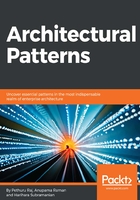
Service-inspired integration (SOI)
Services can integrate disparate and distributed applications and data sources. The Enterprise service bus (ESB) is the service middleware enabling service-based integration of multiple assets and resources. The ESB facilitates service interconnectivity, routing, remediation, enrichment, governance, and so on. The ESB is the integration middleware for any service environment, where the message is the basic unit of interaction between services. An ESB is lightweight compared with previous middleware solutions, such as the EAI hub. The ESB is lightweight because it obviates the need of using custom-made connectors, drivers, and adapters for integrating processes/applications, data sources, and UIs.
Let us consider a sample scenario. Application A is only capable of exporting files to a particular directory and application B would like to get some information out of an exported file in a SOAP message over HTTP. The ESB can implement a message flow that is triggered by a SOAP request message from application B and read the requested information of the exported file of application A with a file adapter.
The ESB gathers the requested information and transforms it into a SOAP message corresponding to an agreed upon XML schema. Then the ESB sends the SOAP message back to application B over HTTP.
The message flow is an important ingredient of any ESB solution. A message flow is a definition that describes where the message originates from, how it arrives at the ESB, and then how it lands at the target service/application. Matching is another prominent functionality provided by the ESB. This function prescribes which message flow must be executed when a message arrives in the ESB.
There are other key functionalities, routing, translation, and transformation of the message format. The routing is all about routing messages from one service to another service. Routing is often used by a message flow module to describe what service will be called for a particular incoming message. The second core functionality is the protocol translation. There are many application and message transmission protocols. An ESB can translate the requester protocol into the provider-compatible protocol. Suppose the requester supports the HTTP protocol and the provider/receiver supports the FTP protocol. Then, this functionality of ESB translates the HTTP protocol to the FTP protocol to enable different and distributed applications to find, bind, and interact. The following figure is the macro-level SOA:

The last core function of the ESB is the message/data format transformation. When a requestor sends a message in SOAP format, the provider can be called by the ESB with an EDIFACT message format. The technology behind such message-format transformations can be the proven XML stylesheet language transformation (XSLT).
SOA is essentially a dynamic collection of services which communicate with each other. The communication can involve either simple data passing or it could involve two or more services coordinating some activity. SOA is based on a conventional request-response mechanism. A service consumer invokes a service provider through the network and has to wait until the completion of the operation on the provider's side. Replies are sent back to the consumer in a synchronous way.
In conclusion, heterogeneous applications are deployed in an enterprise and cloud IT environments to automate business operations, offerings, and outputs. Legacy applications are service-enabled by attaching one or more interfaces. By putting the ESB in the center, service-enabled applications are easily getting integrated to connect, communicate, collaborate, corroborate and correlate to produce the desired results. In short, SOA is for service-enablement and service-based integration of monolithic and massive applications. The complexity of enterprise process/application integration gets moderated through the smart leverage of the service paradigm. The ESB is the most optimal middleware solution for enabling disparate and distributed applications to talk with one another in a risk-free fashion.